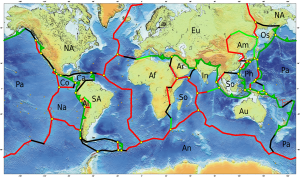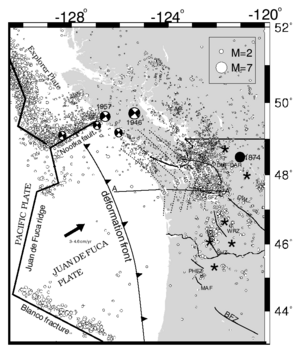Triple junction facts for kids

Imagine the Earth's surface is like a giant puzzle made of huge pieces called tectonic plates. A triple junction is a special spot where the edges of three of these plates meet. Think of it as a three-way intersection for Earth's biggest puzzle pieces!
At each triple junction, the three plate boundaries can be one of three main types:
- A ridge (R): This is where new crust is being made, like a mountain range under the sea. Plates are pulling apart here.
- A trench (T): This is where one plate slides under another, forming a deep ditch in the ocean floor. Plates are crashing together here.
- A transform fault (F): This is where two plates slide past each other horizontally.
Scientists describe triple junctions by the types of boundaries that meet there. For example, you might have a Ridge-Ridge-Ridge (R-R-R) junction, or a Transform-Transform-Trench (F-F-T) junction.
Even though many types of triple junctions are possible, only a few stay the same over long periods of time. We call these "stable" junctions. If four or more plates tried to meet at one point, it would only happen for a tiny moment before changing.
Contents
Cool Places with Triple Junctions

Triple junctions are found all over the world, often in places with a lot of earthquake or volcano activity. Here are some interesting examples:
Afar Triple Junction: A Ridge-Ridge-Ridge Meeting
The junction where the Red Sea, the Gulf of Aden, and the East African Rift meet in the Afar Triangle is a special R-R-R triple junction. It's the only one of its kind that is above sea level! This area is very active, with new crust forming and plates pulling apart.
Rodrigues Triple Junction: Indian Ocean R-R-R
Deep in the southern Indian Ocean, the Rodrigues Triple Junction is another R-R-R spot. Here, the African, Indo-Australian, and Antarctic Plates all come together.
Galapagos Triple Junction: Pacific Ocean R-R-R
The Galapagos Triple Junction is an R-R-R meeting point for the Nazca, Cocos, and Pacific Plates. The East Pacific Rise (a ridge) stretches north and south from this spot. Things get a bit more complicated here because of the Galapagos Microplate, a tiny plate near the junction.
Mendocino Triple Junction: A Busy Coastline
Off the west coast of North America, near Cape Mendocino, is an active F-F-T triple junction.
- To the south, the famous San Andreas Fault (a transform fault) separates the Pacific Plate and the North American Plate.
- To the north, the Cascadia subduction zone is where the Gorda Plate (part of the Juan de Fuca Plate) is diving under the North American Plate, creating a trench.
- Another transform fault, the Mendocino Fault, runs between the Pacific Plate and the Gorda Plate.
Where these three meet is the Mendocino Triple Junction, a place known for earthquakes.
Other Notable Triple Junctions
- Near Mount Fuji in Japan, the Amurian Plate, Okhotsk Plate, and Philippine Sea Plate meet. You can learn more about this in Mount Fuji's Geology.
- The Azores Triple Junction is an R-R-R junction in the Atlantic Ocean, where the North American, Eurasian, and African Plates meet.
- Offshore Japan, the Boso Triple Junction is a T-T-T meeting point for the Okhotsk Plate, Pacific Plate, and Philippine Sea Plate.
- The North Sea in Europe sits on top of an ancient, now inactive, triple junction from the Palaeozoic era, where the Avalonia, Laurentia, and Baltica plates once met.
- The South Greenland Triple Junction was an R-R-R junction where the Eurasian, Greenland, and North American plates spread apart during the Paleogene period.
See also
 In Spanish: Triple unión tectónica para niños
In Spanish: Triple unión tectónica para niños

